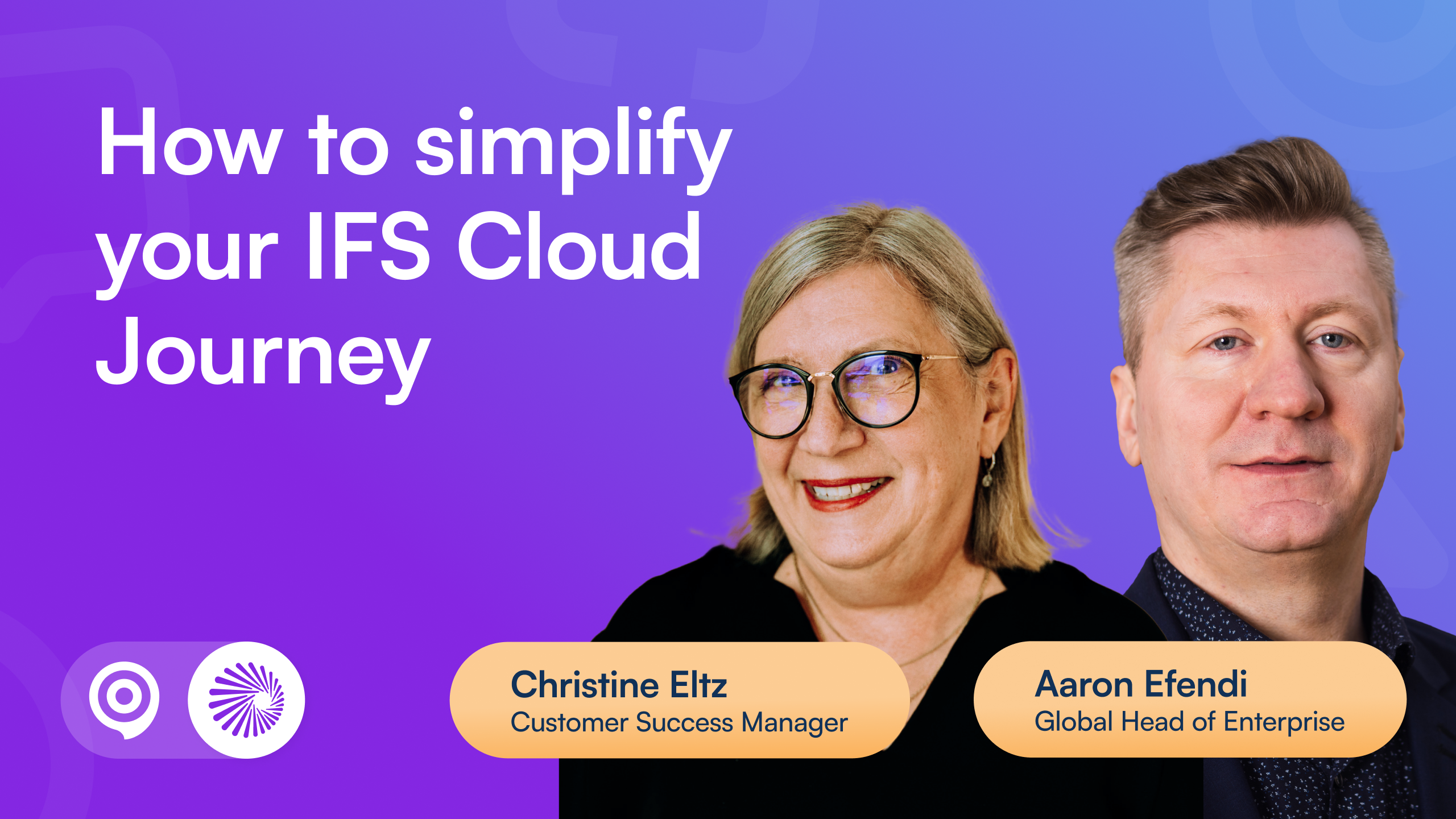Webinar
How to simplify your IFS Cloud Journey

Are you implementing or upgrading to IFS Cloud and concerned with cumbersome user instruction updates, user adoption challenges, or seeking ways to empower your workforce within the IFS platform?
Here is what you’ll learn:
- Accelerate your content creation process
- Keep documentation up-to-date
- Auto–translate user instructions into 45+ languages
- Enhance user onboarding experience and productivity
- Test your application’s processes automatically
Join us for an exclusive webinar where we also unveil the groundbreaking User Adoption Center for IFS Cloud. This innovative release/tool is designed to revolutionize how you approach user training and drive software adoption. Get ready to see the powerful features, how it works – and why your end-users will love this.
- AI-Powered Assistance: Instant answers to user questions, providing real-time support.
- Role-Specific Learning: Personalized, role-based guidance and videos.
- Onboarding on Autopilot: Automated tours for efficient new hire training.
- Learning in the Flow of Work: Contextual help and updates within daily applications.

We collect personal information and use profiling to serve you the most relevant content. In practical terms it means that we remember your choices and preferences when you interact with us. We respect your privacy, and you may unsubscribe/withdraw your consent at any time. For more details have a look in our privacy policy.




How to simplify your IFS journey in 5 steps
Implementing or upgrading to IFS Cloud can be a complex project, but streamlining your training process will make the journey much smoother. Enterprise training managers and ERP stakeholders need practical strategies to ensure users are prepared, confident, and productive from day one. Below, we provide a how-to guide on simplifying the IFS Cloud adoption journey – from preparing users for migration to sustaining user readiness post-go-live – all in a scalable, efficient way.
1. Prepare users for an IFS Cloud migration
A successful IFS Cloud rollout begins long before the go-live date. To manage training and user readiness effectively:
Assess current skills and needs: Conduct a training needs analysis to identify knowledge gaps between your legacy system and IFS Cloud. Use surveys or workshops to gauge users’ readiness and learning preferences.
Create a role-based training plan: Develop targeted IFS Cloud training programs for different user roles. Focus on the new processes and features each group will use, and highlight what’s changing from the old system. Tailored content ensures employees see training that’s relevant to their job.
Start training early: Don’t wait until after the migration. Introduce IFS Cloud concepts and hands-on practice in advance (via sandboxes or pilot environments). Early exposure reduces anxiety and builds user confidence before the switch.
Use multiple training formats: Combine instructor-led sessions, self-paced e-learning, and interactive workshops. A mix of videos, live demos, simulations, and written guides accommodates various learning styles and reinforces understanding.
2. Support global users during IFS Cloud upgrades
Global organizations upgrading to IFS Cloud face extra challenges with dispersed teams, different time zones, and languages. Here’s how to support global users through an upgrade:
Localize training content: Provide translations and localized examples so that users in each region can learn in their preferred language. Ensuring key IFS Cloud documentation is available in multiple languages helps drive adoption across all offices.
Leverage regional champions: Identify power users or trainers in each location who can act as on-site support. These local champions understand cultural nuances and can reinforce training, answer questions, and relay feedback to the central team.
Offer 24/7 accessible resources: Host training materials on a cloud-based platform that employees can access anytime, anywhere. This self-service approach is crucial when users are spread globally – they can review guides or watch how-to videos on their schedule.
Standardize core processes: While allowing for regional differences, ensure that fundamental processes in IFS Cloud are documented in a consistent way. This gives all users a unified baseline understanding of the system, no matter their location.
3. Use automations to keep training up-to-date
One major pain point in ERP rollouts is maintaining training content with each software update. Automation can support training across upgrades and make content maintenance sustainable:
Automate documentation updates: Instead of manually rewriting guides for every IFS Cloud update, use tools or digital adoption platforms that capture processes and generate instructions automatically. By “recording” workflows, you can produce step-by-step documentation in minutes. This saves significant time (organizations report up to 80% time savings using such tools) and ensures accuracy.
Employ AI for changes: Modern solutions can detect changes in the IFS Cloud interface or processes after an upgrade. An author or trainer simply hits a “replay” or update button – the system flags what’s different and updates the training steps accordingly. This means your user guides and e-learning modules are always current, even as IFS Cloud evolves in its evergreen release cycle.
Multi-format content generation: Automation also lets you instantly publish training materials in various formats (documents, PDFs, videos, simulations) without extra effort. Users can choose how they learn best – be it watching a demo or reading a quick reference – all derived from the same source process capture. Consistent, up-to-date content boosts user adoption because learners always have relevant help at their fingertips.
Continuous improvement cycle: With an automated system in place, make it a habit to update and re-publish training content after each minor IFS Cloud update or process change. Frequent, small refreshes prevent knowledge from becoming stale and reinforce a culture of continuous learning.
4. Scale onboarding and enablement for large teams
Rolling out IFS Cloud at an enterprise scale means onboarding possibly hundreds or thousands of users. To scale enablement and onboarding without overloading your team:
Centralize your knowledge base: Create a one-stop online portal or learning center for all IFS Cloud training materials, FAQs, and support. Having a centralized repository (with search functionality) makes it easy for any employee to find answers quickly, which is vital as your user base grows.
Empower “train-the-trainer” programs: Identify key users or subject-matter experts in different departments who can become trainers. By certifying internal IFS Cloud champions, you multiply the reach of your training program. These trainers can host workshops for their teams and provide peer-to-peer support, scaling your efforts organically.
Leverage self-paced e-learning: For a large, distributed workforce, on-demand e-learning modules are a scalable solution. Interactive tutorials, quizzes, and simulations allow employees to learn at their own pace. This flexibility is especially useful for new hires or regions that can’t attend live sessions, ensuring no one is left behind.
Track progress and feedback: Implement tools to monitor training completion rates and gather user feedback. Analytics can show which teams or individuals might need extra help, enabling you to proactively address skill gaps. Continuous feedback also helps improve the training content over time for better results.
5. Simplify the transition from legacy systems to IFS Cloud
Moving from a legacy ERP or older IFS version to IFS Cloud is a significant change. Make the transition easier for users with these strategies:
Communicate the “why” and benefits: Clearly explain to employees why the organization is moving to IFS Cloud and how it will improve their daily work. When users understand the advantages (e.g. a more intuitive interface, less manual work, real-time data), they’ll be more motivated to learn the new system.
Map legacy processes to new ones: Help users draw parallels between how tasks were done in the old system and how they’re accomplished in IFS Cloud. Create quick reference guides that show, for example, “In the old system you did X, in IFS Cloud you will do Y.” This approach leverages their existing knowledge and eases the learning curve.
Provide extra support during go-live: In the initial weeks of the IFS Cloud launch, set up additional support channels. This could mean on-site “floor walkers,” a dedicated chat or helpdesk, or an in-app guidance tool to assist users right when and where they need help. Timely support prevents frustration and keeps productivity high.
Iterate and refine training post-migration: The first few months on IFS Cloud will reveal what users struggle with most. Gather questions and issues that arise, and update your training materials accordingly. Consider hosting refresher sessions or advanced workshops once users have gotten familiar with the basics – this continuous improvement ensures long-term success.
By taking a proactive, organized approach to user training and adoption, enterprise training managers can truly simplify their IFS Cloud journey. From planning early and addressing global needs to harnessing automation for upkeep, these strategies will help your workforce embrace IFS Cloud with confidence and competence – ensuring strong user adoption and long-term productivity.